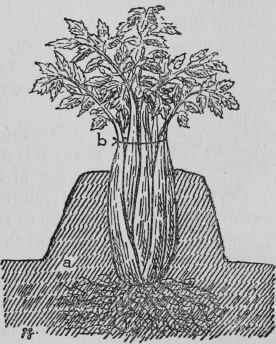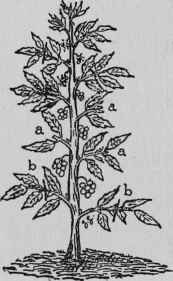August - First And Second Weeks. Vegetables
Description
This section is from the book "The Garden Week By Week Throughout The Year", by Walter P. Wright. Also available from Amazon: The Garden Week by Week Throughout the Year.
August - First And Second Weeks. Vegetables
Asparagus
Interest in Asparagus beds is not, as a rule, so lively in August as in May, but it should be remembered that the success of the spring crop depends in a great measure on the growth which the Asparagus makes the previous summer. The wise grower keeps his beds free from weeds, and nourishes the plants with occasional soakings of liquid manure, or dustings with chemical fertilisers. Nitrate of potash, at the rate of an ounce per square yard, is a splendid stimulant, and worth using, in spite of the fact that it is rather dear.
Beans
Broad Beans will be over, and may be cleared off the ground. Dwarf French Beans can only be kept growing and bearing by constant picking of the pods while they are still young. Scarlet Runners should also be picked regularly. If large pods are wanted for exhibition, the clusters may be thinned. It is a help to the plants to give liberal doses of liquid manure, and a mulching of short yard manure along the rows will further strengthen them, and help them to continue bearing until autumn. See that the Runners are well supported, and in case of doubt add a few fresh poles and stays, or the row may be blown over in a gale.
Cabbages
Another sowing of Cabbages may be made for spring use. See preceding chapter for varieties. The soil should be fine, friable, and moist. The seedlings should be thinned early, and the hoe run between the rows frequently, in order to keep the plants moving steadily. It is important that they should make uninterrupted growth, as then they will be strong enough for planting out in October, and are not likely to run to seed in spring. Seed of Red or pickling Cabbage may also be sown now: the plants will form large, solid hearts the following summer.
Cauliflowers
Plants for autumn use that were planted between Potatoes should be examined. It is very undesirable that they should be overgrown. Keep the soil loose about them, and give soakings of water, followed by liquid manure, if the soil should get dry.
Celery
Early Celery will now be benefited by attention. Any suckers springing from the base should be picked out, and the stems can be drawn together and tied with raphia. This will help extension, which will be further stimulated by copious applications of water. If produce is wanted for show, or for use at a particular time, brown paper may be tied round it, or earth drawn up to the stems, about a month beforehand.

Fig. 61. - Tying and Earthing Celery.
a. New soil heaped from the bottom of the trench. 6. The plant tied to prevent soil lodging in it.
Lettuces And Endive
It is common to make a sowing of Lettuces in August for use early in the following year. They are treated like Cabbages - that is, planted out in autumn, and wintered in the open air. Of the older varieties, Hicks' Hardy White and Black-seeded Bath (Cos), and Stanstead Park (Cabbage-shaped), are particularly good for the present sowing, because they are hardy sorts. Sow thinly half an inch deep in moist, friable soil. Broad-leaved Batavian Endive may be sown similarly.
Onions are also commonly sown in the early part of August. Lemon Rocca is a good variety, and may be sown an inch deep.
Spinach
The Prickly - seeded Spinach is often sown early in August for use in winter, but it "is a somewhat uncertain crop, owing to its liability to run to seed, and the Viro-flay and Victoria are perhaps more reliable varieties. The soil should be fertile, friable, and moist; if dry at sowing time it should be moistened. The drills may be drawn an inch deep and eighteen inches apart, and the seedlings should be thinned in due course.
Tomatoes
Any help that is possible to Tomatoes swelling up a crop of fruit in the garden should be given now. One thing that can be done is to reduce the foliage, either by cutting away part of the large leaves, or by removing some of the lower ones entirely. Tomato plants should never be stripped of their leaves entirely, but the gradual removal of the lower ones is advisable, as it encourages the swelling and colouring of the fruit by the greater concentration of sap and exposure. Another step is to cut round the plants at a distance of about nine inches; this severs the strong, outgrowing roots, and thereby helps to check growth.

Fig. 62. - Defoliating Tomatoes.
a. Leaves partly cut away.
b. Leaves to be severed at the dark cross lines.
Winter Greens
Any ground that becomes vacant by the removal of Broad Beans, Peas, Potatoes, and other crops, and is not wanted for any special purpose, may be planted up with surplus Winter Greens. The ground is now very warm, and if the plants are watered in they will grow rapidly.
Continue to:


